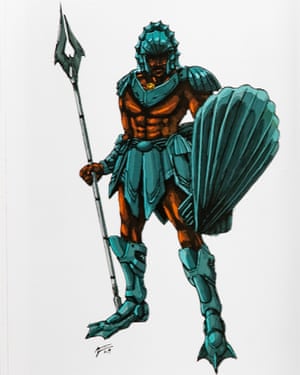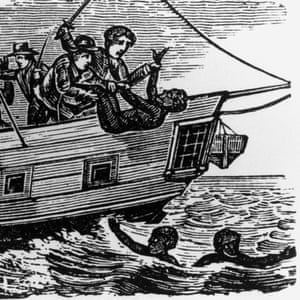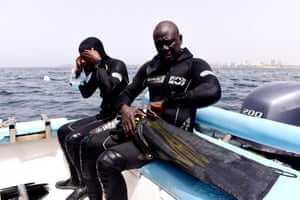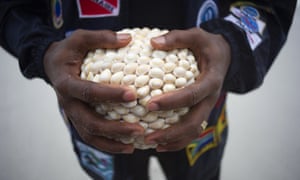Somewhere in the dark, vast abyss of the Atlantic Ocean, deep beneath the waves, lies a civilisation. For centuries the Drexciyans have lived in peaceful isolation on the seabed, occupying their bubble metropolis, unaware of the land-based realm their ancestors were forced to leave behind.
The Drexciyans trace their lineage back to the pregnant African women – considered by their captors to be sick or disruptive – who were thrown off slave ships to drown. Baby Drexciyans swam from their mothers’ wombs, never needing to breathe air, and gave rise to a subaqueous empire.
Drexciya, of course, does not technically exist. It was created by the Detroit electro duo of the same name in their 1992 album Deep Sea Dweller, and over the course of a decade was expanded through an acoustic techno-soundscape of bubbly arpeggios and watery synths, with track names and artwork drip-feeding clues to fans about who the Drexciyans were and where they came from.

-
Drexciyan baby and (below) warrior, from Abdul Qadim Haqq and Dai Sato’s graphic novel, The Book of Drexciya
In 2017, the Drexciyan mythos inspired the actor and rapper Daveed Diggs – famous for his role in the musical Hamilton – to write a song with his hip-hop group Clipping called The Deep, which described a Drexciyan uprising against greedy humans firing seismic air cannons into the ocean in the hunt for oil.

The legend of Drexciya has since been adopted by other artists – such as in a novel, also called The Deep, by Rivers Solomon, and in Abdul Qadim Haqq and Dai Sato’s graphic novel, The Book of Drexciya.
What all the Drexciyan tales have in common is an attempt to deal with the trauma of slavery by imagining an alternative narrative. And while this Afrofuturist water race is fictional (and there is no known record of pregnant women being cast to sea from slave ships), Drexciya has helped inspire a new movement that is very real indeed: namely, proposals to create an ocean memorial to the victims of slavery.
Amazingly, despite the number of victims – the infamous “Middle Passage” of the Atlantic is the final resting place for at least 1.8 million people from Africa who died on slave ships and were thrown overboard – there is no international memorial to the role of sea crossings in the horrors of the slave trade.
Perhaps it’s not entirely surprising that no such memorial exists, given that the bodies all vanished.
“The whole point of putting bodies into the sea was that nobody would find them,” says Charlotte Sussman, professor of English at Duke University, North Carolina. “It poses a particular problem when what you’re trying to commemorate are people who were deliberately lost.”

-
Daveed Diggs, of Hamilton fame, wrote a song describing a Drexciyan uprising with his hip-hop group Clipping
Sussman belongs to a group of academics who, inspired by the Drexciyan mythos and other creative interpretations of the Middle Passage (including in poetry and art), have proposed the idea of a memorial. They say it would have contemporary cultural as well as historical significance.
“In the context of the transatlantic slave trade, poetry, music, art and literature describe the Atlantic seabed as a space with cultural significance,” the authors note. “Finding ways to recognize this intangible cultural heritage is as important as establishing procedures to respect and preserve human remains, shipwrecks and artefacts”.

-
A map of the ‘triangular slave trade’ between Britain, its American colonies, and Africa in the 17th and 18th centuries
Various ideas have been floated. One is to formally change the maps of the International Seabed Authority (ISA) to add “ribbons” marking the main slave trading routes. The idea is likely be put forward at the next ISA council meeting.
Not coincidentally, the proposed ISA map resembles the sleeve notes of Drexciya’s 1997 album The Quest, in which maps depict four stages of the Drexciyan mythology: from west Africa to North America; moving across the continent; fanning from Detroit across the world; and finally “ribbons”, or lines, reaching from the Americas east across the Atlantic Ocean to west Africa (labelled “The Journey Home (Future)”).

Another idea is to trace the story of an individual, as Sussman did with a team of humanities scholars at Duke University. Using ship logbooks that document the approximate locations where Africans were cast into the Atlantic, the Duke project followed one person, identified on the slave ship The Good Hope only as “small boy”. On 11 May 1757, at 3am, in hazy visibility but with a fresh breeze blowing (the logs callously note the weather alongside the number of deaths from the day before), this boy is recorded as having died of “flux”, an ambiguous medical condition that may have been dysentery.
“That one little adjective, ‘small’, was the most description of anybody on the list,” Sussman says. “Everybody else was just ‘man’ or ‘woman’.”
The academics told the boy’s story on a dedicated memorial webpage, including how, after dying in agony, and with none of the traditional mortuary practices of the Bullam kinship network in Sierra Leone to which he may have belonged, he was cast to sea at 10.92o N latitude, -35.42o W longitude.

-
The infamous “Middle Passage” of the Atlantic is the final resting place for at least 1.8 million Africans
Another proposal is to honour some of the ships that never made it. More than 1,000 slave ships are estimated to have sunk in the Atlantic, presenting the possibility of creating in situ memorials. One such memorial already exists: in 1700, the slave ship Henrietta Marie was on its way to England with no captives when it capsized on a coral reef off Florida. In 1993, the National Association of Black Scuba Divers placed a memorial plaque on the wreck site, facing west towards African shores. Other ships could be honoured in a similar form.
Other less physical, but still powerful ways of memorialising have involved forging human connections between the past and present.
“We have this pervasive sense of shame and silence around this phenomenon and that shouldn’t be,” says Kamau Sadiki, lead instructor at Diving With Purpose, a group of scuba divers that search for wrecks of slave ships to piece together stories of captives.
In 2015, he was working with the Slave Wrecks Project (based at the National Museum of African American History and Culture in Washington DC) when they found the wreck of the Sao Jose Paquete de Africa, a slave ship that sank in 1794 off Cape Town, South Africa, drowning all the Africans on board. With the help of archaeologists, they traced the dead to Mozambique, specifically the north-east area of Mossuril, and paid their descendants a visit. After informing them about the ship’s discovery, they returned with soil from Mossuril to lay on the site of the Sao Jose in a ceremony.

-
Underwater archaeologist Ibrahima Thiaw (R) and a team member during a diving expedition to find traces of shipwrecks off the island of Goree near Dakar, Senegal
Some argue that memorials can be more creative than literal, such as at the Legacy Museum and National Memorial in Montgomery, Alabama, where samples of soil from lynching sites throughout the southern US are displayed in a wall of glass jars, each bearing the name of a victim.
Or there is the work of Forensic Oceanography, whose Left-To-Die Boat project used an array of surveillance tools to illuminate the story of a migrant boat in distress that was abandoned to drift in the Mediterranean for two weeks in 2011, unassisted by nearby Nato vessels. Sixty-three migrants on board died.
Social media is another tool for memorialising atrocities: one account sends out hourly tweets remembering a particular person who was murdered in the Holocaust. Solomon, the novelist, thinks a digital memorial could be a suitable choice for slavery in Middle Passage.
“It sounds so simple, but there’s something about being confronted with it, and faced with it, that I think can really touch us,” they say.
“Obviously my book, as well as Clipping’s The Deep, and Drexciya’s albums, is a fictional exploration,” they add. “But honestly, I think adding that element of wonder is something that inspires interest and curiosity and passion, for people to take a look.”

-
A diver holds an urn containing sand from Mozambique that was scattered in the sea near the wreckage site of Portuguese slave ship Sao Jose Paquete de Africa, off Cape Town, South Africa
Whatever form it ultimately takes, the need for an ocean slavery memorial is particularly urgent, say proponents, because of plans for deep-sea mining. Seabed mining could be approved for commercial purposes by the ISA this year, but is still being discussed chiefly in economic and environmental concerns.
“How we treat that space, and how we engage in activities there, should be considerate of every viewpoint,” says Phillip Turner, one of the academics from Duke University calling for the cultural and historical importance of the ocean to be considered.
Mining ventures, for example, could destroy wrecks of slave ships and other evidence of atrocities. The trade actually entered its deadliest phase at sea after Britain made slavery illegal: some captains, caught by Royal Navy ships patrolling the African coast, tied captives to anchor chains and threw them over the side. “The crime was only punishable if you had evidence in the form of actual human beings on your ship,” says maritime archaeologist James Delgado, one of the memorial study co-authors. Delgado believes that with modern underwater surveying tools it would be possible to find evidence, such as metal anchors with shackles still attached.
If maritime archaeologists such as Delgado were allowed to work closely with mining operators, they could help protect such artefacts, as is stipulated in the draft ISA rules. As yet, however, there is no plan to include them.
For now, at least, it is the Drexciyans – living in their bubble metropolis, riding the Aquabahn to work, fighting back against the humans trying to exploit them – who remain one of the only tributes to this horrifying chapter in the ocean’s story.

-
The Book Of Drexciya recreated a world first imagined by a Detroit band of the same name
The “ribbon” map idea for the ISA could be a more formal sign of honour and respect.
“This is not about stopping mining,” says Cindy Lee Van Dover, Duke University deep-sea biologist and co-lead author of the paper. “It’s about remembering that this tragedy happened.”
“Our human history, our stories, what happened to us, our cultural legacies, are extraordinarily important, informative and shape who we are today,” says Solomon. “[They] should be at the forefront for how we think about how we’re going to engage with the environment, how we engage with the ocean.”

-
Divers scatter sand from Mozambique in honour of the Africans who died on the Sao Jose Paquete de Africa